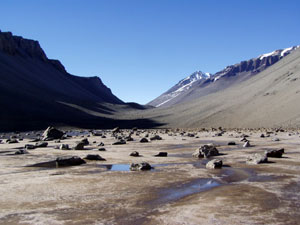






 |
 |

Don Juan Pond in the Wright Valley
Caption:
Don Juan pond, located in the Wright Valley of the Transantarctic Mountains, is one of the saltiest bodies of water on Earth. Dr. Diane McKnight's research team from the University of Colorado monitors the water of the lake. Dr. McKnight's research is being conducted as part of a Long Term Ecological Research (LTER) Program project. NSF began the LTER Program in the United States in 1980 as a way to gather broad-based ecological data over a long timescale; the Dry Valleys were added in the early 1990's. To learn more about Dr. McKnight's research, see the NSF publication United States Antarctic Program, 2002-2003.
NSF started the LTER Program in the United States in 1980 as a way to gather broad-based ecological data over a long timescale; the Dry Valleys were added in the early 1990's. [See related images: Algae Beds at Bottom of Lake Hoare, Beacon Valley Field Camp, LTER in Garwood Valley.]
More about this Image
The McMurdo Dry Valleys LTER project is an interdisciplinary study of the aquatic and terrestrial ecosystems in a cold desert region of Antarctica. The overall objectives of the McMurdo LTER are to understand the influence of physical and biological constraints on the structure and function of dry valley ecosystems, and to understand the modifying effects of material transport on these ecosystems.
The McMurdo Dry Valleys are located on the western coast of McMurdo Sound (77°00'S 162°52'E) and form the largest relatively ice-free area (approximately 4800 square kilometers) on the Antarctic continent. The dry valleys are dominated by microorganisms, mosses, and lichens, and higher forms of life are virtually non-existent.
The LTER research in the McMurdo Dry Valleys of Antarctica is very important not just because the area is unique, but because it exists at one end of the arid and cold spectra of terrestrial ecosystems. All ecosystems are dependent upon liquid water and shaped to varying degrees by climate and material transport, but nowhere is this more apparent than in the McMurdo Dry Valleys. In very few places on Earth are there environments where minor changes in climate so dramatically affect the capabilities of organisms to grow and reproduce. Indeed, the data being collected by the LTER indicate that the dry valleys are very sensitive to small variations in solar radiation and temperature and that the site may well be an important natural regional-scale laboratory for studying responses to human alterations of climate. While the Antarctic ice sheets respond to climate change on the order of thousands of years, the glaciers, streams, and ice-covered lakes in the McMurdo Dry Valleys respond to change almost immediately. Thus, it is in the McMurdo Dry Valleys that the first effects of climate change in Antarctica should be observed.
The McMurdo Dry Valleys LTER project has successfully completed eight field seasons (October-February) since 1993. During the 1993-94 season 18 scientists were deployed to McMurdo Station and Taylor Valley to conduct research associated with the LTER project. These scientists initiated core measurement programs to obtain baseline ecologically relevant data from the atmosphere, glaciers, streams, soils, and lakes. Since then, about 25 scientists each season have participated.

(Preview Only)

|
| Credit: |
Photograph by Jenny Baeseman, University of Colorado; NSF |
| Year of Image: |
2003 |
|
Categories:
BIOLOGICAL / Ecological
BIOLOGICAL / LTER (Long Term Ecol Rsh)
POLAR SCIENCE / Antarctic
Formats Available:
Restrictions:
No additional restrictions--beyond NSF's general restrictions--have been placed on this image. For a list of general restrictions that apply to this and all images in the NSF Image Library, see the section "Conditions".
|